Stack Overflow’s 2022 Developer Survey results are out, and Node.js is continuing at the top with a 46.31% stake as the most popular web framework for Web app development. It is also the second most popular project on Github with over 101,000 stars. Surprisingly, the demand for Node.js developers has surpassed that of PHP developers – which is the oldest, most widespread web technology.
The signal is loud and clear – companies are rapidly prioritizing Node.js as the preferred choice for developing web apps, and the adoption has only gone upwards.
Editor’s note: If you’re determined to be among the companies using Node.js and want to step up, browse Simform’s web app development deliverables and discuss your requirements.
Why are famous companies using Node.js apps?
Node.js solves a list of production challenges for top organizations. Some are platform-related, while others are focused on resource utilization. Across the board, Netflix, Paypal, Linkedin, all have admitted to loading-time savings of up to 60% as reported by Hackernoon.
Speedtest.net, a popular tool for benchmarking internet speed, is itself using Node.js. Amongst others, better developer productivity, lower development cost, and higher app performance are the top reasons why companies use node.js apps.
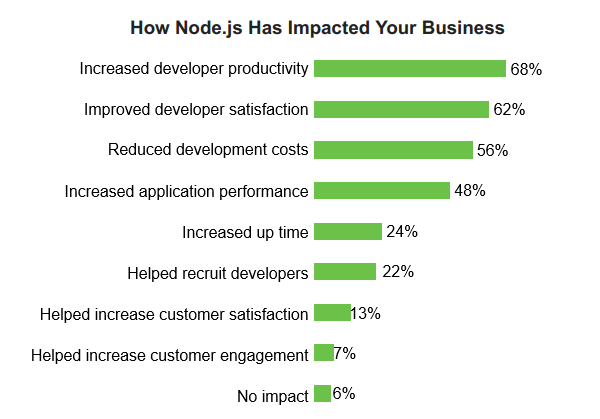
source: nodejs.org
List of companies using Node.js. Here are our favorite 15
To understand the rising trend, it is crucial to study which companies use node.js, the challenges they faced, and how node.js helped them solve those challenges. Therefore, we have selected the top 15 companies using Node.js and prepared a case-by-case guide to help you understand why you should also move to Node.js.
1. Netflix
Lowers startup time with Node.js

Netflix, which has over 260 million subscribers worldwide (October 2023), has been trying to improve interface loading speed for better user experience. Until 2015, it was using a JAVA backend, which was useful for data management but offered poor user-wait times. Since Javascript frontend didn’t communicate efficiently with the JAVA backend, Netflix decided to move to Node.js to leverage the performance benefits of node.js.
Why Netflix moved to node.js
- Monolithic application design made it hard to scale the application with the growing user base.
- The transition from the backend to the frontend was not smooth, resulting in higher load time, often causing latency at the end-user level.
- UI customization as per user needs was hard to achieve due to synchronous loading.
- JAVA’s bulky build time reduced development and deployment speeds.
Benefits of Node.js to Netflix
- A dramatic 70% lower startup time. Netflix interface that took 5-10 seconds earlier, now just took a little over 1 second.
- JAVA’s 40 minute startup time came down to 1 minute with Node.js.
- The application became microservice oriented, making it easy to break up the UI in smaller segments, rather than one large block.
- As Node is also Javascript, the backend to frontend transition was significantly improved.
“Node has proven so handy, that the company is expanding its use to other layers of the stack”, said Kim Trott, director of user interface engineering at Netflix.
2. NASA
Improved database access time with Node.js

NASA, the aeronautics pioneer, was facing difficulties in consolidating its dispersed legacy databases related to EVA Spacesuits. It made it difficult for scientists to access databases for research purposes. Data access was slow and required rummaging through multiple locations to get the data for proper research.
Collin Estes, who designed the Node.js enterprise architecture for NASA, describes how the system needed an API-driven architecture. When you ask which companies use Node.js, you don’t expect NASA, but it’s true for the following reasons.
Why NASA moved to node.js
- Data recorded by Spacesuits were spread across different locations.
- Most of NASA’s space mission data is siloed in sealed databases that are hard to query and sort.
- NASA was operating on-premise data centers, which weren’t cloud-ready.
- Many of NASA’s existing applications were Javascript dependent.
Benefits of Node.js to NASA
NASA made several key transformations in regards to cloud-readiness and portability of data.
- 300% improvement in the time needed to access the database, allowing users to get desired data sets in seconds and not hours.
- The Node.js microservices architecture made it possible to move legacy databases to the cloud and make them available to users via APIs.
- The earlier 28-step database reading process came down to 7 steps with Node.js. Scientific research is done with much greater ease in much less time.
- Smooth connection of legacy Oracle and SQL Server databases to new cloud databases via data API modules.
The data synchronization made possible by Node.js is helping everyone from Astronauts to ground crew for safe and speedy access to NASA’s vast databases.
3. Trello
Achieved quick prototyping with Node.js

The team at Trello, the famous Kanban-style project management tool, was looking for a lightweight server with snappy loading speeds. Given that Trello is built on Coffeescript, a language that compiles Javascript, the developers prioritized Javascript nativity.
Trello needed an even driven technology that could process multiple concurrent requests at once. Hence, Node.js became the first choice for precisely those reasons.
Why Trello moved to node.js
- The application needed instant updates with minimum latency.
- As most of Trello’s architecture is Javascript based, a server with a similar methodology was required to make the code maintainable and faster to develop.
- Trello required several real-time open connections on the server to maintain the speed and delivery of updates.
Benefits of node.js to Trello
Node.js app helped Trello in quick prototyping and delivered on expectations as a Javascript-friendly event-driven server.
- Trello engineers were able to keep the Single Page Application extremely lightweight (250 Kb) using Node.js.
- The server interactions facilitated by Node.js offered zero latency.
- The development and prototyping time was cut short using Node.js architecture.
“This (using Node.js) was a very fast way for us to get started trying things out with Trello and making sure that the design was headed in the right direction.” Trello’s official blog quoted.
4. PayPal
Decreased its loading time with Node.js
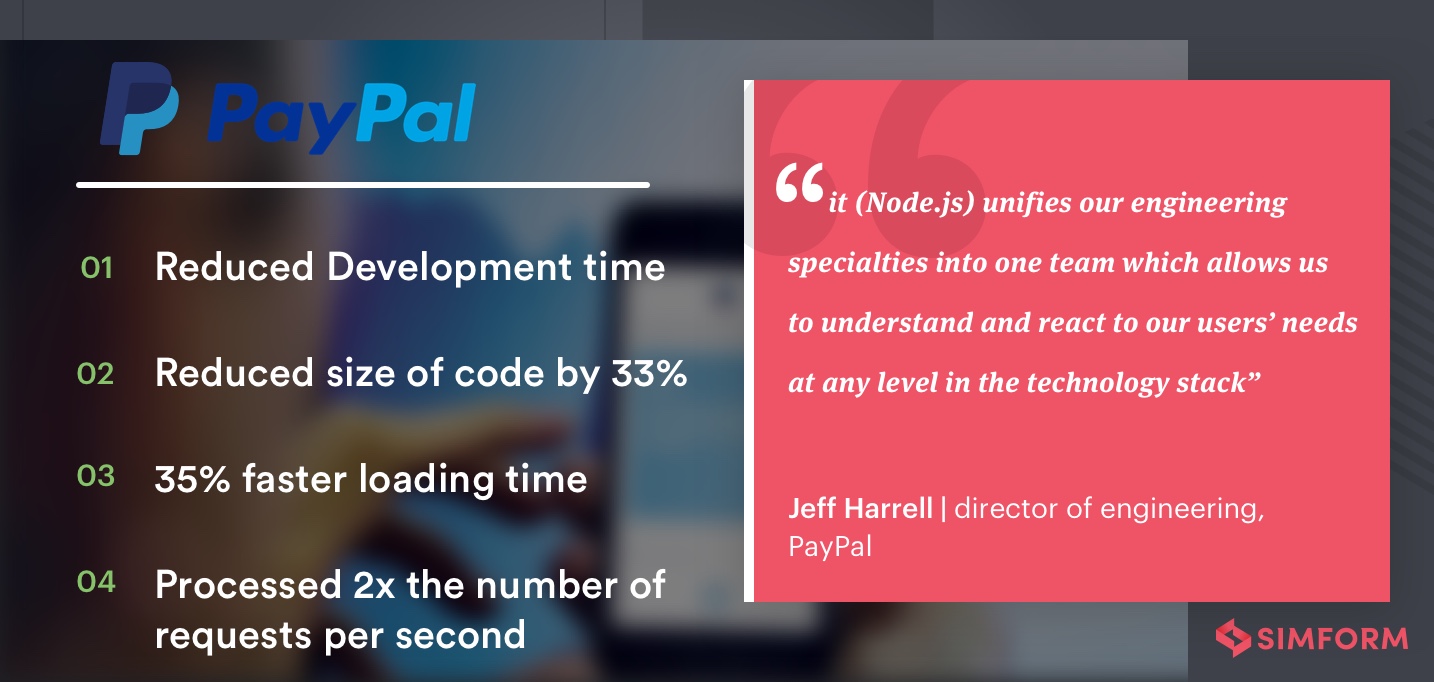
PayPal, has 428 million users for digital payments, was facing the same JAVA to Javascript transition problems like Netflix, resulting in reduced loading time and payment processing issues.
The engineers were skilled at JAVA, but because of a Javascript front-end, several disparities arose in the development process. As a solution, in 2013, PayPal decided to migrate from Java to Node.js, becoming one of the very first companies to do so.
Why PayPal moved to Node.js
- Different development processes for JAVA development that didn’t sync well with front-end development.
- The development time for the JAVA application was relatively high with poor performance,
- JAVA’s high environmental dependencies resulted in lost productivity at PayPal.
Benefits of Node.js to PayPal
PayPal not only witnessed unexpected results in terms of development but also application performance.
- Node.js app was built in half the time with an even smaller team that worked on the JAVA application.
- The size of code shrank by 33%, with a 40% reduction in the number of files used by the application.
- PayPal pages started loading 35% faster, with a decrease in response time.
- The Node.js application was handling twice the number of requests per second.
“It (Node.js) unifies our engineering specialties into one team which allows us to understand and react to our users’ needs at any level in the technology stack.” Jeff Harrell, director of engineering at PayPal said in his blog post.
5. Linkedin
Improved its app performance with Node.js

Linkedin, the world’s largest professional network, has more than 1 billion users. It is also one of the biggest apps that deploy Node.js in production.
LinkedIn, for a long time, was working Ruby on Rails before switching to Node.js. This decision was primarily based on increasing app performance and decreasing resource usage. By employing Node.js as their backend, they moved from synchronous to asynchronous request processing, which offers much faster interface loading speeds.
Why Linkedin moved to node.js
- The server took too much load whenever there was an increase in Traffic.
- Linkedin couldn’t process multiple concurrent requests with Ruby implementation.
- The Ruby App worked synchronously, making the pages heavier to load.
Benefits of Node.js to Linkedin
Node.js app helped LinkedIn reduce their resource usage and improved app performance.
- LinkedIn was able to reduce the machines used to host their app by a ratio of 10:1.
- The client and server both came under the Javascript regime, making it easier for development teams to handle the client-server interaction.
- The code was simplified across the board, making it more modular and less state-dependent.
“Node.js also enabled us to move to a model where the client makes a single request for a page. The code was simplified and we moved to stateless servers.” said, Deepank Gupta is a Senior Software Engineer at LinkedIn on a Medium blog.
6. Walmart
Enhances website experience with Node.js
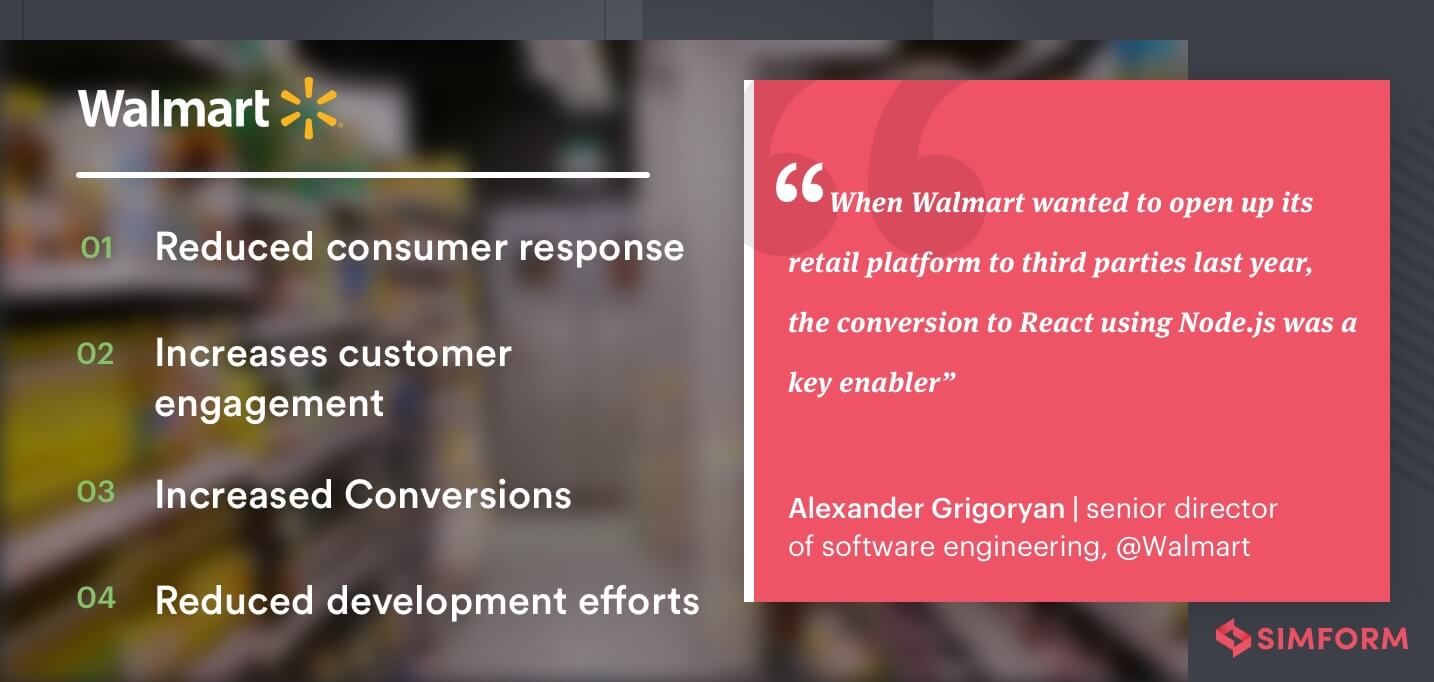
Walmart, the leading supermarket giant, wanted its e-commerce website optimized for better performance while being agile enough for distributed teams.
Walmart’s e-commerce website and mobile app attract nearly 80 million users in a month, which called for a system robust enough to handle so many requests. Their crucial target areas were; faster-loading speeds, an HTML-based front-end, and the shift to the microservices architecture that their current JAVA application couldn’t offer.
Why Walmart moved to node.js
- Monolithic JAVA web app was hard to work with for distributed teams. They needed modularization of the app.
- The pre-Node Javascript front-end used Javascript libraries that were not SEO friendly, reducing searchability of products in the eyes of the Search Engine.
- Walmart’s mobile eCommerce applications were also facing performance issues due to the JAVA setup.
Benefits of Node.js to Walmart
Walmart was able to develop an HTML-friendly website for search engines and also increased website performance with Node.js app.
- Walmart implemented a combination of React JS and Node.js for its front-end, which bettered their website performance. They noticed a decrease in consumer response time and an increase in customer engagement.
- Walmart Checkout Cart showed increased conversions.
- The development teams were pushing updates faster than ever, decreasing development effort and times.
“When Walmart wanted to open up its retail platform to third parties last year, the conversion to React using Node.js was a key enabler”, said Alexander Grigoryan, Walmart senior director of software engineering.
How to Build an eCommerce Web Application using Node.js?
7. Uber
Eases ride processing with Node.js

Which companies use Node.js inside out? The simple answer is Uber. Uber is one of the very first large scale adopters of Node.js in production. Uber has a distributed architecture with a large number of modules that communicate with each other via APIs. Since it processes millions of concurrent requests, node.js was a perfect fit for them.
Several components of the Uber Mobile App use Node.js for critical operations such as trip execution and connecting 600+ APIs. Uber is shifting some components to Go, but Node.js continues to play an essential role in its technology stack.
Why Uber moved to Node.js
- Uber needed a real-time and speedy API driven architecture that could process millions of connections at a time.
- Uber uses several fragmented microservices to power its infrastructure, which demands a backend that could band things together.
- The company wanted to run advanced analytics on the vast amount of data generated by its platform, which could be best done when services interact correctly.
Benefits of Node.js to Uber
Uber was able to create a reliable, self-healing, distributed environment for Web and Mobile App which heavily relies on Node.js.
- The component that is responsible for executing trips is built on Node.js. It benefits from the asynchronous and single-threaded event loop of Node.js, making it highly reliable.
- Uber can process a large number of user requests.
- Uber’s API ecosystem has over 600 stateless endpoints that are all written in Node.js, that increases connectivity and reduces management overheads.
Uber is probably the best example that uses most of the Node.js features to power 14 million trips daily. It has seamless integration in the backend as well as front-end interfaces.
8. Twitter
Achieves 5 seconds loading speed with Node.js

Twitter, with its massive user base of 330 million monthly active users, was looking to improve performance for its mobile website, mobile.twitter.com. The website is one of the largest sources of traffic for Twitter. It was earlier serving the same Twitter desktop site on mobile phones, but then it shifted to Node.js to introduce new improvements.
Why Twitter moved to Node.js
- Abiding by the mobile-first ideology, Twitter wanted to develop a refined mobile experience as more than 80% of users access Twitter on a mobile device.
- A large chunk of Twitter’s ad revenue comes from mobile devices (nearly 88%). Better loading speeds and usability were needed to improve ad click rates, which the current site wasn’t geared for.
- Twitter’s Desktop Site was not optimized for slow or patchy connections and video streaming on mobile.
Benefits of Node.js to Twitter
The new Twitter Lite employs a totally API-driven architecture that works using Node.js. It offers better availability, fast loading speed and mobile data savings.
- Twitter Lite is only 1-3% of the Twitter iOS or Android App, which is excellent for storage space saving on mobile devices.
- The mobile website loads under 5 seconds, even on a 3G speed connection and is optimized to work on 2G connections speeds.
- The app uses asynchronous processing derived from Node.js implementation that first loads the content in the viewport.
- The design and development speeds have also increased, pushing iterations faster than ever.
- Twitter Lite is much cheaper to maintain than Twitter Desktop and Twitter Mobile.
“We really re-wrote everything, and that includes the back end on Node.”
James Bellenger, senior software engineer at Twitter Inc
9. Yahoo
Simplified feature releases with Node.js
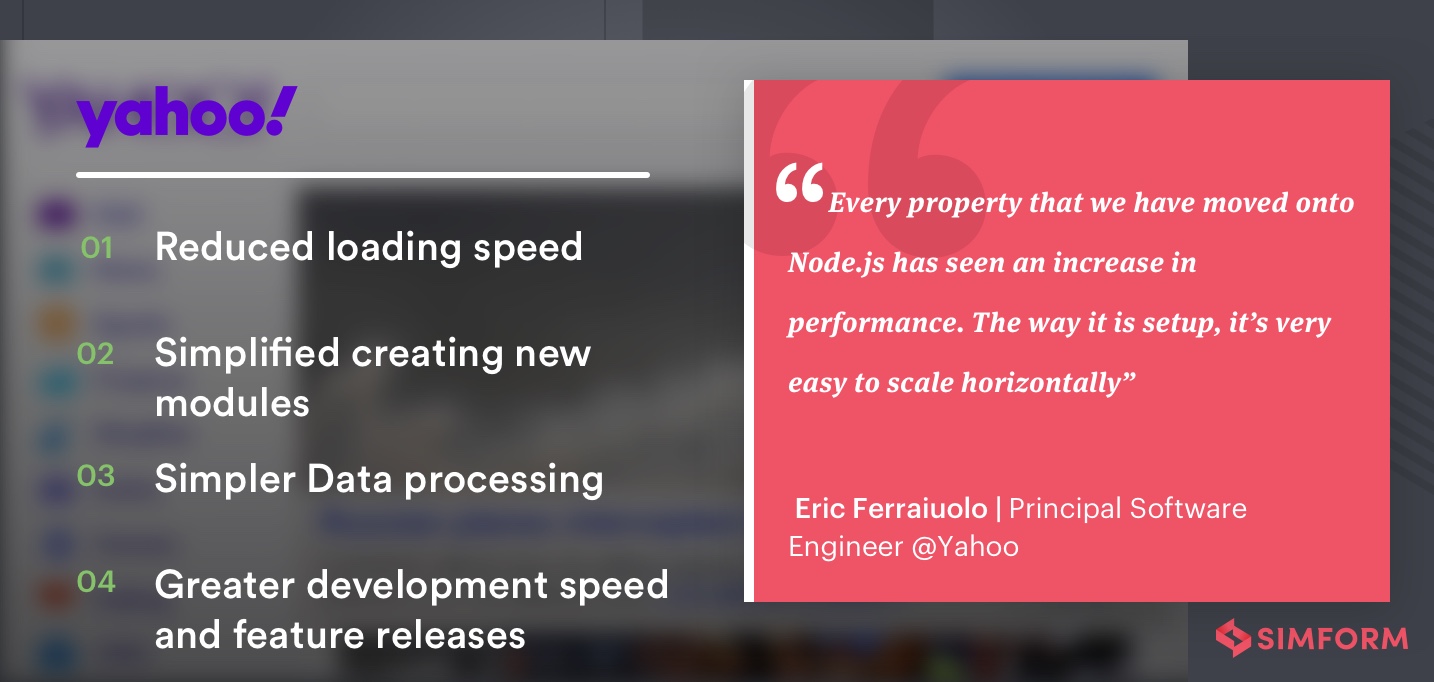
It’s not surprising that Yahoo Life, Yahoo Food, and Yahoo Answers, all use Node.js. Yahoo is another early adopter of the technology into production, starting from Node version 0.8. Even Flickr, which is owned by Yahoo, leverages Node.js for serving high-traffic photo pages quickly and reliably.
Why Yahoo moved to Node.js
- Yahoo is a content-heavy platform that requires quick loading speeds and user request processing at scale.
- Yahoo’s Flickr platform, which gets more than 7 billion API requests, needed a reliable server-side processor to handle all the requests with minimum latency and failure rate.
- The development teams needed to shift the code to a more Javascript-friendly platform for backend and frontend synchronization.
Benefits of Node.js to Yahoo
- Yahoo saw performance improvements across a horde of its products and slowly shifted to Node.js. These were mainly related to loading speed and the ability to create new modules more freely.
- The recently added photo commenting feature is developed entirely on Node.js, making big data processing simpler.
- Yahoo has achieved greater development speeds and feature releases with much lower infrastructure and human resource usage.
“Every property that we have moved onto Node.js has seen an increase in performance. The way it is setup, it’s very easy to scale horizontally” said Eric Ferraiuolo Principal Software Engineer, Yahoo in a video blog.
10. eBay
Reduced resource utilization with Node.js
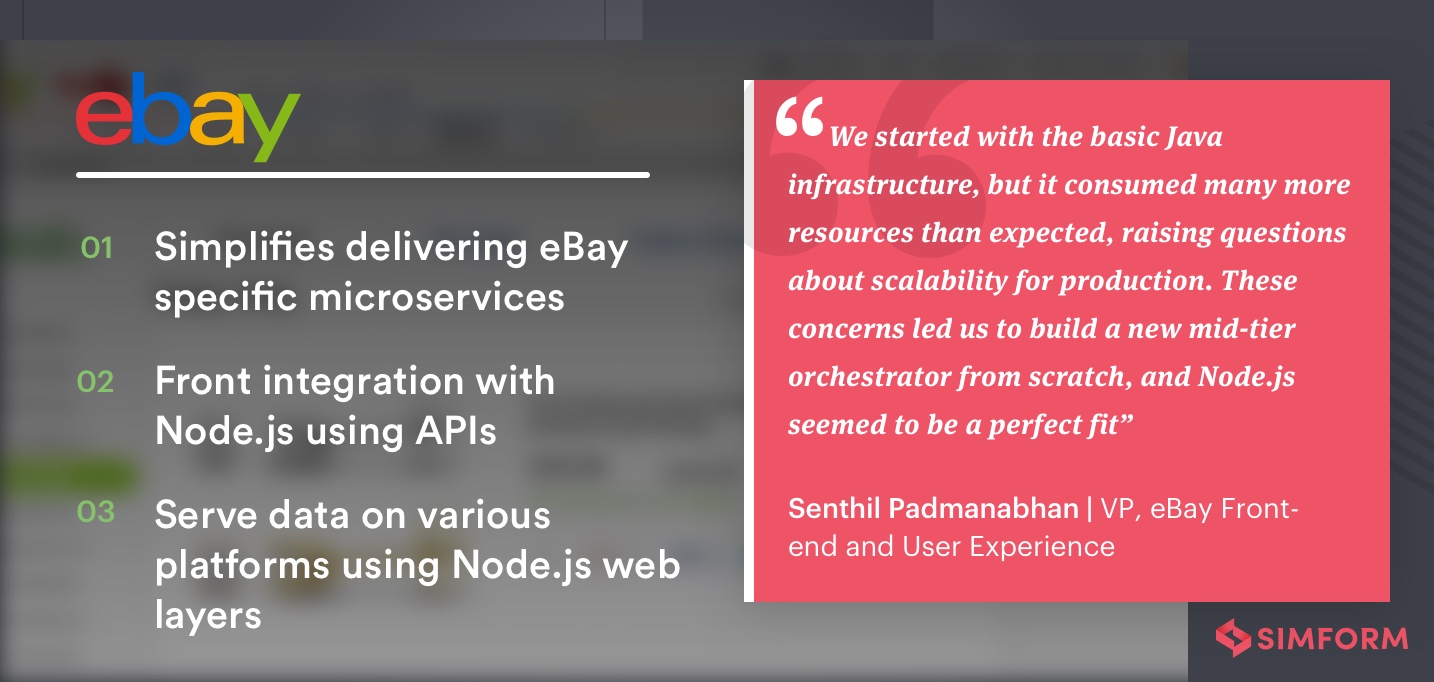
eBay receives a billion service requests every day, becoming one of the largest marketplaces in the world and one of the top companies which use node.js. It had been using a JAVA-based architecture for a long time before shifting to Node.js.
eBay, just like PayPal and Netflix, faced platform issues with JAVA and wanted a lighter runtime that could bode well with the front-end. The disparity between the front and back end code, made the website slow for the users.
Why eBay moved to Node.js
- Ebay’s legacy JAVA application presented with long startup times and slow website performance, eBay wanted to make their app as real-time as possible.
- Ebay’s backend needed connections to several platforms such as iOS, Android, and the web-based platform. A component-based stack was required to achieve the same as the current model wasn’t geared for deploying microservices.
- The front-end engineering team wasn’t able to bring development to speed and iterate codes faster.
Benefits of Node.js to eBay
eBay embraced the open-source model of Node.js apps, combining open-source libraries to build a perfect ecosystem for developers.
- They were able to deliver a massive number of eBay specific microservices using Node.js in real-time without burdening the infrastructure.
- The front-end was also shifted to Node.js using APIs that the team was looking to achieve for a long time.
- Serve its data on various platforms, freely and quickly using Node.js web layer.
“We started with the basic Java infrastructure, but it consumed many more resources than expected, raising questions about scalability for production. These concerns led us to build a new mid-tier orchestrator from scratch, and Node.js seemed to be a perfect fit.” said Senthil Padmanabhan, VP, eBay Front-end and User Experience.
Check How We Helped Our Client, Swift Shopper, To Build E-commerce Solutions Using Node.js
11. GoDaddy
Showed 4x higher end-user performance with Node.js
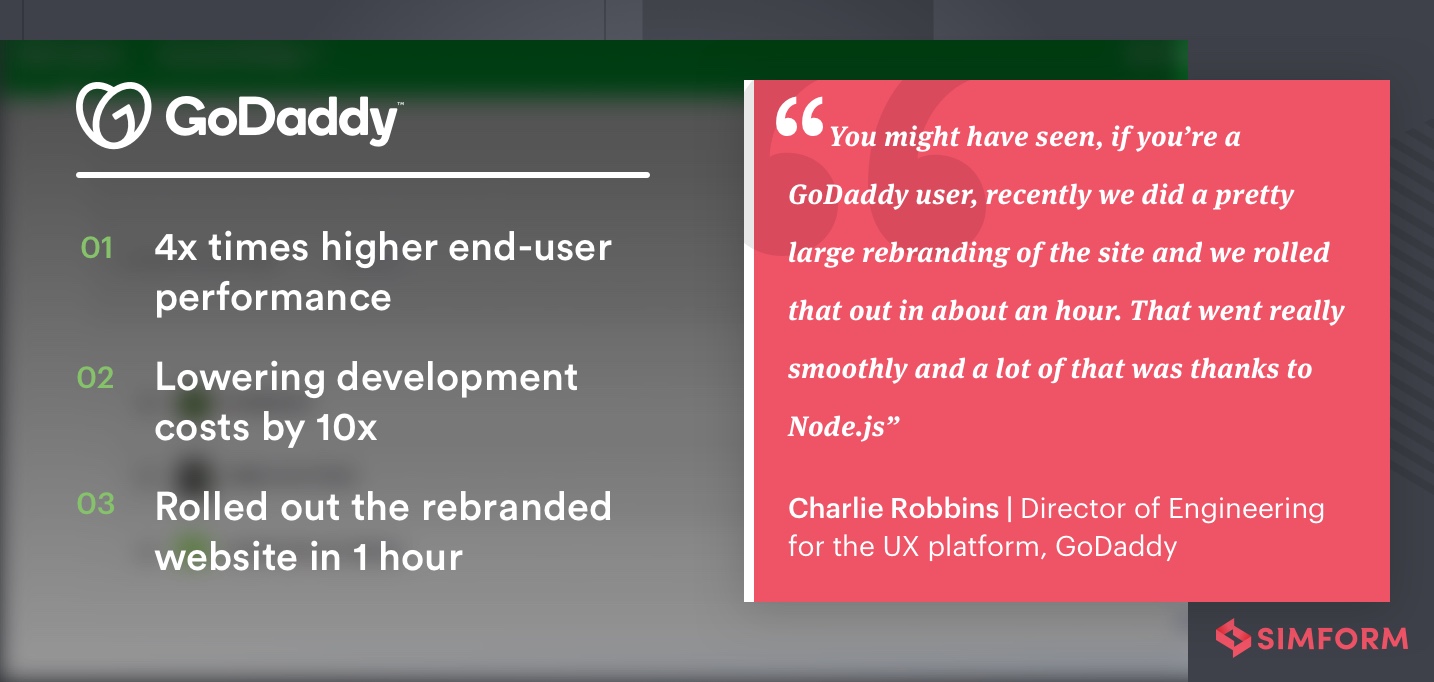
GoDaddy, one of the world’s largest hosting and domain name providers, is also one of the biggest companies backing node.js. GoDaddy’s switch took place when they redesigned their website in 2016. The key priorities were to reduce server load occupied by the Website Builder platform, reduce costs, and offer better performance to the users.
Why GoDaddy moved to Node.js
- As GoDaddy is a web hosting provider, it was looking for a server-client that could reduce server load, and bring down costs.
- GoDaddy also wanted to increase performance on their website builder tool, which is a crucial attraction for the end-users.
Benefits of Node.js to GoDaddy
- 4 times the higher end-user performance in their web hosting services, making websites hosted on GoDaddy perform better.
- They could also bring down costs by a factor of 10 due to the lighter Node.js runtime.
- Rolled out the rebranded website in 1 hour.
“You might have seen, if you’re a GoDaddy user, recently we did a pretty large rebranding of the site and we rolled that out in about an hour. That went really smoothly and a lot of that was thanks to Node.js.” – said Charlie Robbins, Director of Engineering for the UX platform at GoDaddy
12. Groupon
Achieved scalability with Node.js

Groupon, an e-commerce giant with more than 40 million active users, was facing scalability issues for business growth. It deployed a JAVA and Ruby on Rails architecture, which was monolithic & hard to maintain.
Furthermore, Groupon had deployed a PHP stack in South America and another JAVA stack in Europe, causing development hurdles.
Why Groupon moved to Node.js
- In 2019, the Groupon app reached 200 million downloads. The Ruby on Rails architecture presented scalability challenges.
- Groupon was using three different technology stacks in the backend.
- Groupon also wanted to unify their frontend stack with Javascript, to decrease design complexity, which hampers development speed.
Benefits of Node.js to Groupon
Groupon was able to successfully shift to a Javascript-friendly web layer that was easy to scale and was consistent across the project.
- Groupon was able to successfully deploy Node.js to bring their Ruby and JAVA backends together. 3400 backend-services are running on Node.js, which resulted in high availability for its growing user base.
- 50% faster-loading speed.
- Reusable codes helped the company save a lot of man-hours in development.
- Groupon developers also found Node.js as a suitable alternative to make their platform migration smooth and free of complexity.
“We’ve just finished migrating our U.S. frontend from Ruby to our new Node.js infrastructure. The old monolithic frontend was split up into approximately 20 separate web apps, each of which was a clean rewrite.” – said Adam Geitgey, Director of Software Engineering at Groupon
13. Medium
Speeds up content processing with Node.js
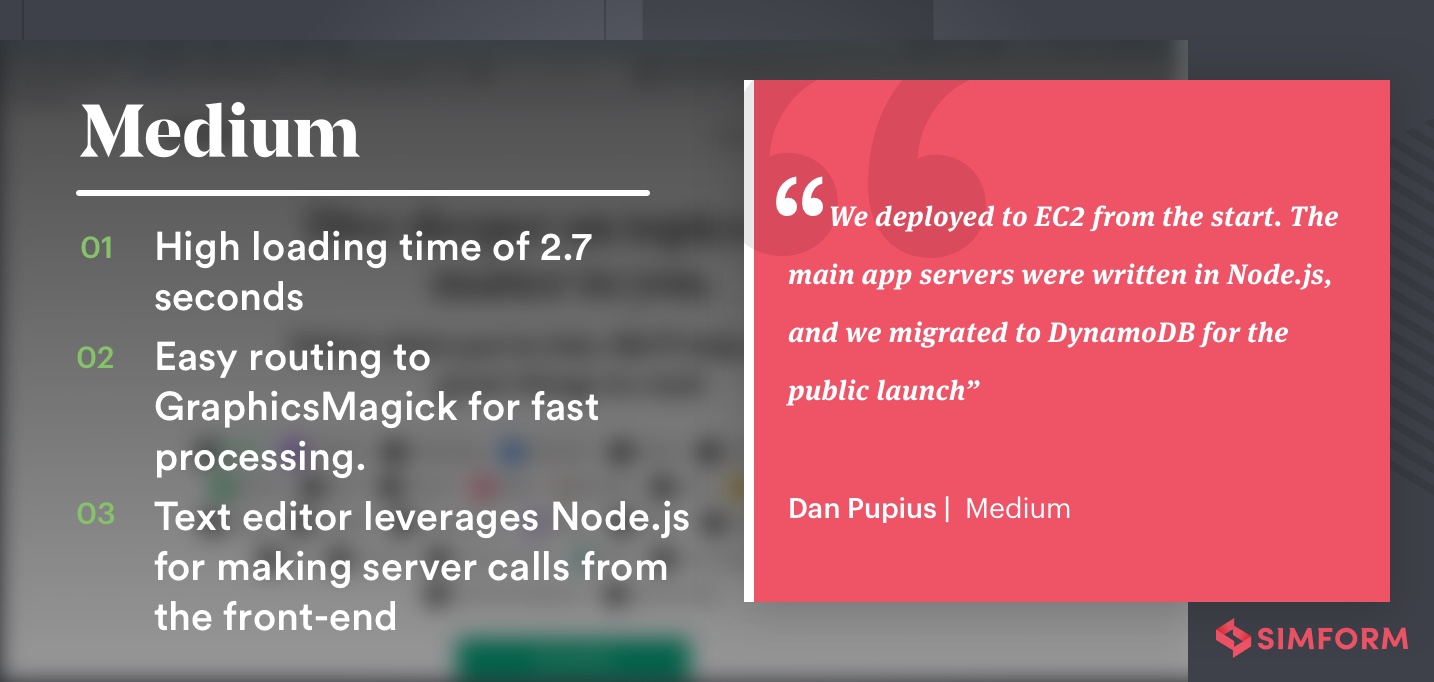
Medium is a Content and Blogging platform, with about 25 million monthly unique users. It’s one of the few companies that use Node.js and AWS right from the beginning.
Why Medium moved to Node.js
- Medium needed a Javascript runtime, as most of its web front-end is in React.js. There was a need to maintain platform uniformity, which accelerates development.
- Medium had around 7.5 million posts in 2016, which demonstrates its requirement for big data management with minimum server load.
- As Medium offered a web-based text editor for blog post publishing, it had to uphold the performance standards for its expanding user base.
Benefits of Node.js to Medium
- Loading time of mere 2.7 seconds even with large images and content processing.
- Node.js implementation made it easy to route images to GraphicsMagick for quicker processing.
- The Medium text editor leverages Node.js for making server calls from the front-end. Node.js provides for a smooth transition, enhancing the user experience for the publishers.
“We deployed to EC2 from the start. The main app servers were written in Node.js, and we migrated to DynamoDB for the public launch.” said Dan Pupius at Medium
14. Yandex
Created numerous APIs with Node.js.

Yandex is a Russian search engine popularly known as “the Google of Russia.” As of January 2021, Yandex has about 3.2 billion searches per month, of which 92% are originated from Russia. While initially the company was introduced as a search engine, with time, it started providing over 70+ internet-related services.
Why Yandex moved to Node.js
- Yandex’s tech stack was already relying on JavaScript heavily. Being an open-sourced JavaScript framework, Node.js aligned with their existing technology stack.
- Subdomain of Yandex, YuMoney decided to use node.js for their backend needs due to its asynchronous nature.
- Yandex needed something that could help them in easily communicating with their JAVA-based backend architecture.
Benefits of Node.js to Yandex
- By using Node, Yandex was able to lower the latency of their cross-platform runtime environment.
- They were able to create numerous APIs using Node.js like yandex-music-api, yandex-translate, etc.
- YuMoney used Node.js as it executes Javascript code in a single thread. This makes handling multiple client requests easy.
“Node.js has become popular thanks to its extensive NPM repository, an impressive developer community, and the ability to use JavaScript on the client, on the server, and for tool development. In general, our team liked all these advantages, so the choice was obvious.” – said Roman Ponomarev (Team, YuMoney)
15. Citibank
Achieved 50% lower latency with Node.js.

Citibank is a leading global bank with nearly 2.5 thousand branches spread across 19 countries. It was already a part of the Javascript-based technology ecosystem. However, recently, they onboarded Hapi.js, one of the Node.js frameworks. This move came after Walmart’s success with Hapi.js and Node; and the fact that it was befitting with their already existing tech stack.
Why Citibank moved to Node.js
- As Citibank shifted towards cloud computing, they needed something that fits well with modern-day massive distributed computing like docker, VMs, platforms in services and clouds, etc.
- Citibank needed a strong backend service, and Node.js aligned perfectly with their existing technological stack.
- Node.js is known to be handy for mobile protocols like messaging, webs, and different integrations.
Benefits of Node.js to Citibank
- By implementing Node.js, the Citibank team was able to develop many plugins for their web apps.
- With the use of NTLM authentication of Node.js, they were able to make the authentication secure and straightforward.
- By leveraging Nginx direct delivery of Nodejs, Citibank achieved 50% lower latency.
“We chose Node to primarily work on improving our enterprise application, reverse proxy, and exposing services,” said Aman Kohli (Principal Architect, Citibank)
Bonus:
1. Capital One
Eased API data formating using Node.js

Capital One is an American bank holding company, specialized in credit cards and loans with the majority of operations across Canada, the United Kingdom, and the United States. Recently, they decided to shift priority towards open-sourced technologies and included Node.js into their already impressive tech stack.
Why CapitalOne moved to Node.js
- Capital One moved to Node.js for its APIs and microservices needs.
- It needed a framework for developing the UI of its DevOps dashboard known as Hygieia.
- It used Node.js for providing functionality to its angular directive named OneUI.
Benefits of Node.js to CapitalOne
- Node.js provided lag-free real-time data to its dashboards.
- Being high-performant and scalable, Capital One deployed Node.js as an orchestration layer between their frontend and backend.
- Node.js implementation made it easier to format the data of JAVA APIs.
“Node.js has the potential to be both for startups and big companies, which I think is a really unique phenomenon.” – said Azat Mardan (Technology Fellow at Capital One)
2. Mozilla
Expanded its framework’s support with Node.js
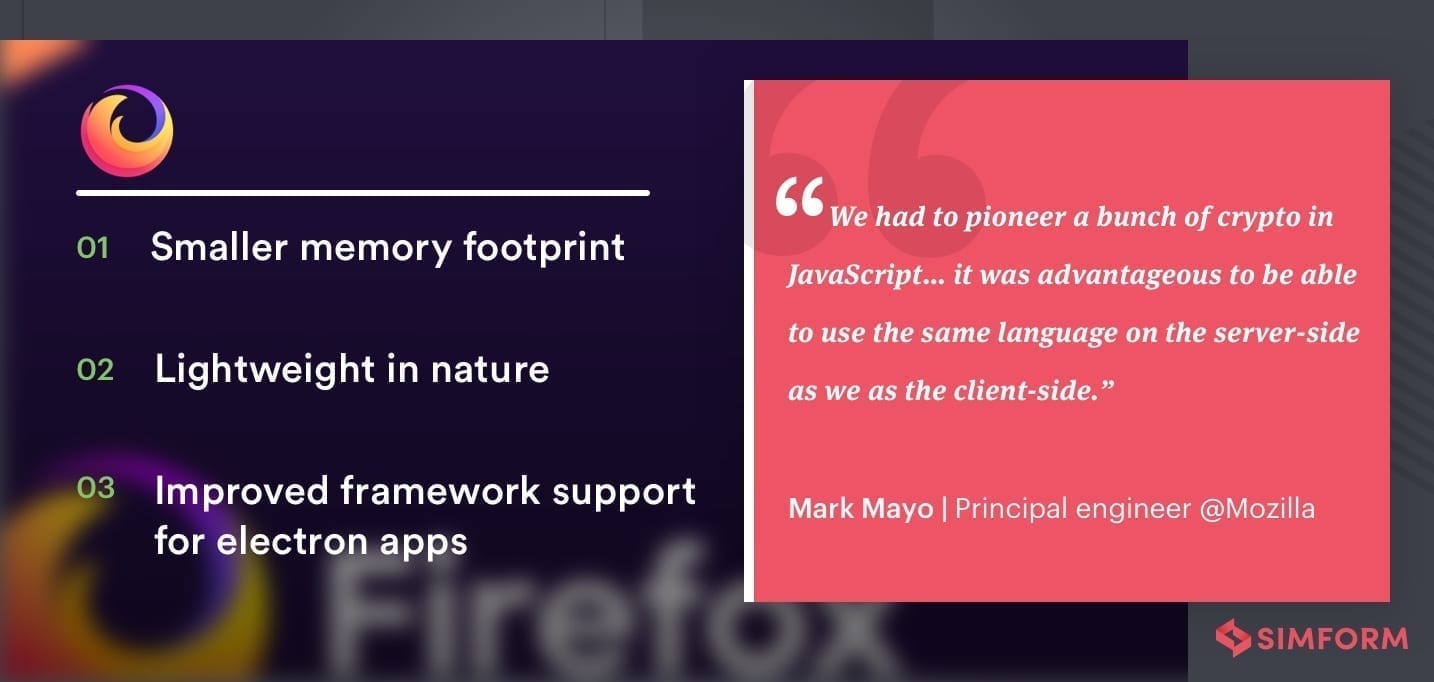
Established in August 2005, Mozilla Corporation is responsible for the development of several internet-based applications such as the famous Firefox web browser. The company is also behind the creation of an open-sourced programming language known as Rust. Rust was created to help developers make the most out of modern-day multi-core processors.
In early 2016, the company joined forces with tech giants like IBM, Intel, Microsoft, and NodeSource and worked on Node.js API projects.
Why Mozilla moved to Node.js
- Mozilla needed something lightweight and has a commendable memory capacity for its web applications.
- Using Node for the server-side made it easy as they were already a pioneer of cryptography in Javascript.
Benefits of Node.js to Mozilla
- The memory footprint of Nodejs is minimal compared to other open-sourced frameworks. Leveraging this, Mozilla is focused on designing Browser ID (cross-platform authentication technology) to support half a million users.
- The company is working on SpiderNode, which is implementing Nodejs over SpiderMonkey (Mozilla’s JavaScript engine).
- Using Node.js Improved the framework’s support for running electron apps.
“We had to pioneer a bunch of crypto in JavaScript. It was advantageous to be able to use the same language on the server-side as we as the client-side.” – said Mark Mayo (Principal engineer at Mozilla)
Conclusion
If Node.js was an excellent fit for these companies, does that mean it will be an excellent fit for you? The short answer is – if you’re facing similar challenges as these companies, Node.js is a step in the right direction. The adoption of Node.js in production by big names ensures that it will continue to receive support, and will only grow into better technology.
This is why Node.js is a part of our tech stack for web applications that have Netflix-like performance needs or eBay-like scalability expectations.

